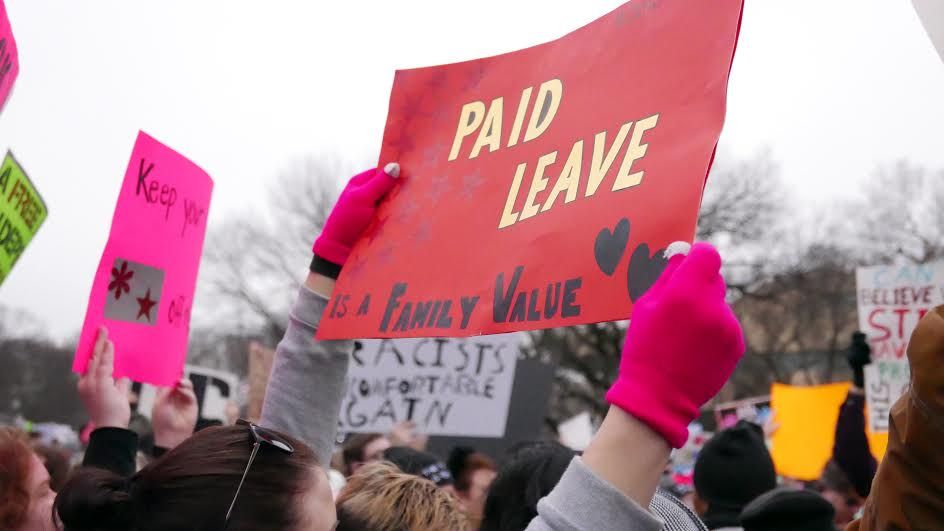
"Paid Leave is a Family Value" sign in the Women's March on Washington, DC, Jan. 21, 2017. (Photo courtesy of Ellen Bravo)
This Q&A is part of Sarah Jaffe’s series Interviews for Resistance, in which she speaks with organizers, troublemakers and thinkers who are doing the hard work of fighting back against America’s corporate and political powers.
Ellen Bravo, co-director of Family Values @ Work, a network of coalitions in 24 states winning paid sick days and paid family medical leave insurance, talks with Sarah Jaffe about President Trump’s proposed family leave plan, part of his newly released 2018 budget. The plan seeks federal funding for a new program that would provide six weeks of paid parental leave for parents after the birth of their child, as well as adoptive parents. This interview has been edited and condensed (read the full interview here.)
Sarah Jaffe: Donald Trump’s budget has some provisions that they are saying looks like paid leave. Can you talk about what is in those proposals and what, perhaps most notably, is not in them?
Ellen Bravo: I have been thinking a lot about shell games. In order to win a shell game, the person has to get your eyes on one shell while they are manipulating the others. That is what this budget is. They are hoping that by naming “paid leave” we won’t notice that they are slashing and destroying everything from Medicaid to food stamps to child care to disability payments, etc.
Secondly, the paid leave itself, they call it paid family leave, but of course it is paid parental leave. It doesn’t deliver even for parents. The problem is it is relying on an unsustainable funding source, state unemployment insurance. They are already grossly underfunded and leave out large numbers of people. The states will get to set the eligibility and amount of payment for your benefit and it is only for six weeks. So too little time for too little money for too few people.
It is going to be another shell game to say that the money will come from reducing fraud in unemployment insurance, which is greatly exaggerated as a problem. Essentially, it will mean states will have to cut unemployment benefits to laid off workers in order to have money for the parental leave and of course it’s the same people. There will be someone who needs one and later the other or their partner. Then, they get to decide who qualifies. So if you are an unmarried couple, same sex couple, adoptive parents, how do you get certified, who gets to be considered legitimate?
— Ellen Bravo
Then, the vast majority of reasons people need leave isn’t for a new child; it is for their own illness or for caring for a loved one. That, of course, isn’t covered. This is a budget that delivers only to one group and that is the wealthiest corporations and the wealthiest individuals. It slams the rest of us and then tries to use this as a shell to make us think there is something in it for us, but when you look, not even very deep, you see that it is unworkable and it leaves out the essential elements of the program.
SJ: Of course, this was supposed to be Ivanka Trump’s baby. I remember during the campaign seeing these ads with Ivanka Trump sitting on a couch talking about how her dad was going to give us all paid family leave because he cares about women. Ivanka has this book out now which is the Ivanka Trump version of Lean In, I guess. It has been fascinating because there has been this strand of “Lean In” feminism that is led from the top and thinks about these policies mostly in terms of women at the top. It has been fascinating to watch that be co-opted by this very right-wing president. I wonder if you could talk about the way Ivanka Trump has been mobilized on this issue and what that says in a country where, again, 53 percent of white women voted for Donald Trump.
EB: Sheryl Sandberg, to her credit in Lean In, acknowledges from the start that she is privileged, with resources the majority of people don’t and that there is a need for massive changes in public policy for the majority of women. Ivanka Trump is unaware of how the majority of people live.
There is a great Samantha Bee clip, in which Ivanka Trump is saying, “Well, if your child is sick, there goes your balance because surely you are going to stay home that day.” Samantha Bee says, “And the next day and the next because your boss who is not your dad at the chicken processing plant is going to fire you for having a sick kid. Follow your bliss.”
SJ: You have been fighting on this front for a very, very long time. Let’s talk about what a real paid family leave plan would look like, what real family policy would look like.
EB: That is the good news; we know exactly what it looks like because we have a proposal on the table and that proposal has been spurred by successful programs in three states and two more have now won and five more are on the horizon to win.
Here is what we have learned. First of all, we call it an AAA rating. A program needs to be accessible, affordable and adequate. Notice I say “adequate” and not “ample” because what we are asking for is modest not only compared to what families need, but also to what the rest of the world, literally, offers.
What does that mean? Accessible means for all families, for all reasons for leave, and recognizing that caregiving is a good thing and we shouldn’t punish people because they are being a good child to their parents or a good parent to their child or a good partner or following doctor’s orders. It should be affordable for families and for businesses. Small businesses don’t want [President Trump’s] unemployment model because it may well result in higher taxes for them and that is hard for them. They want to provide paid leave for their workers who can’t afford it on their own social insurance program, which is the model I am describing. You pool very small contributions and there is enough money in the pool that workers who need leave can draw a good portion of their wages while they are out.
That is the next thing; to be affordable also means that the highest percent of wage replacement should go to those who earn the least and that there should be job protection. This is what we have learned from the programs in place, and they are all now going back to improve them. The new ones that are being passed, like in Washington, DC, workers who earn up to 150 percent of the minimum wage will draw 90 percent of their wages while they are out on leave. Washington state is doing that for even a higher number of people.
Finally, it should be an adequate amount of time — time that is decent for bonding or for healing. We know from the American Academy of Pediatrics, for example, that means at least 12 weeks; seeing 12 weeks as a basic minimum for bonding with infants and surely for people recovering from cancer surgery, etc. Even for a C-section, the time that the Trump plan sets is six weeks. You have a C-section, your doctor says you need at least eight weeks, maybe 12 weeks. [The Trump plan] is completely wrong.
SJ: Right now, because the administration is obviously not going to give us much in the way of real family policy, a lot of these struggles are going on in the states and have been going on in the states for decades. Talk about where some of the local struggles have been successful, where are some of the local struggles going on right now, and how can people get plugged into building family policies that work wherever they are.
EB: We encourage all the people who are listening or reading this to go to FamilyValuesAtWork.org and sign up. We will plug you in wherever there are struggles going on or help you start new ones.
The good news is that there are lots of states that are involved in this and they include states that are on the brink of winning it, like Massachusetts and Connecticut and Oregon and Washington and others. They also include states like Montana and Wisconsin, where it is going to be a much harder struggle, but where they are building these broad and diverse coalitions bringing together people who care about ending poverty, care about public health, care about maternal mortality and infant mortality rates, care about breast-feeding, care about child development and about seniors and so on.
— Ellen Bravo
We like to talk about the intended consequences of what we are winning. One of those intended consequences is getting people to see that change is possible and that they are the agents of that change and understanding what happens to us that we have been told is up to us to fix, in fact, is a systemic problem. Together we can come up with a solution. There is, by the way, a federal bill, the FAMILY Act, that is inspired by these state wins sponsored by Sen. [Kirsten] Gillibrand (D-NY) and Rep. [Rosa] DeLauro (D-CT). We are helping build support for it and making it an issue.
We should see the elections in 2018 and 2020 as a “Which side are you on?” moment and get people to pony up. Will they support the things that working families need? Are they really valuing families? Do they really care about women’s equality? Do they really care about ending racial discrimination? These are the kind of policies we need and we need to see where they stand.
SJ: The movement for paid sick leave, paid family leave, things like this, has really grown alongside the movement for higher wages, alongside the Fight for $15. We have seen the policies go hand-in-hand in a lot of places where they will raise wages or they will do paid sick days and they will do the next thing and then they will look for the next thing. It has been interesting to me to watch the development of these questions and policies around time and time off. There are these fair scheduling acts, as well, that are moving forward in a lot of places. Right now, we are looking at a Trump Labor Relations Board that is not going to be terribly friendly to workers’ rights, but it is interesting to see, nonetheless, the way the movement is developing its thought on certain issues. I wonder if you want to talk about the way that thought and organizing around time and time off has been developing over the years you have been working on this.
EB: When we started Family Values @ Work in late 2003, the people who were part of fighting for good jobs, did not think about time to care. The people who were fighting poverty didn’t think about work, they just thought about safety nets. The people who talked about working families didn’t talk about low-wage workers, they just talked about professionals and mainly women. The candidates weren’t talking about these issues, and largely the women’s movement wasn’t either.
All of those things have changed now. People who put out proposals for good jobs understand that it doesn’t matter if it is $15 an hour if you get zero dollars an hour because your kid is sick or because you have a baby. People who are looking for local hiring realize that you can’t get a decent job and then be kicked out of it just because you are doing exactly what we tell you to do as a society in terms of being a responsible parent, etc. That has really been exciting to see. Clearly, there has been a lot of effort to make those connections, but there is a lot more cross-sector movement work going on.
Another example of that is making sure that our definition of “family” is as broad as possible in both the paid sick days, because paid sick is just a few days a year for reaching illness that happens to everybody, where paid family and medical leave is for the longer leave — you are a patient or need for welcoming a new child or for a serious personal or family illness. People are realizing that we have to make sure the definition of “family” includes all families, LGBT families and chosen families and immigrants and others who have extended families. That has been really great seeing those kinds of partnership develop.
SJ: The biggest response to the election of Trump was the Women’s March. It has been interesting to watch the development of this resistance movement as something that is often defined very specifically as feminist. There have been some struggles around this, obviously. We can talk about the Democratic Party still struggling with whether or not it is going to make abortion access central, but, I was struck by the rise of both the Women’s March as this really massive — possibly the biggest demonstration in US history — and then some of the actions that have followed that. I wonder what you think about all of this as, again, somebody who has been watching he tides of feminism shift in this country for a little while.
EB: What was so great about the Women’s March was the intentional efforts that were welcoming to the vast majority of people there to link movements and issues and to say, “Can we talk about women without talking about all women?” If we are talking about all women then we have to realize that what happens to you if you are black or Palestinian or an immigrant or a lesbian, etc., that matters also to your life as a female. That is one thing.
I think some people realized a deeper way of looking at it is also that what hurts someone else, one of these groups, strengthens the hand of those who would deny women equality. We have to understand who we are talking about, who the opposition is, and go beyond the broad vague sense of “men” to the people who really do benefit from discrimination and talk about power and talk about systemic change.
I think there were a lot of people for whom this was new. They just hadn’t encountered it much before. It was a lot of jubilation and rage mixed together at the march. So it is not surprising to me that so many people went back and said, “I can’t not continue doing this. I have to find ways to stay active and involved and I have to think about if they do a Muslim registry, I will be the first in line to register even though I am not a Muslim. I will not let this happen.” There are people who have never thought much about immigration who are realizing, “I need to be part of watch groups and others who try to do everything we can to make our city welcoming and safe and to fight efforts to use law enforcement in this punitive way.”
That has been really exciting to see. And just all of our coalitions have had lots more activists and people wanting to get involved. I think the Women’s March was the spark that showed people how much power and sense of urgency and possibility we can make happen and it has helped make sure that continues.
Interviews for Resistance is a project of Sarah Jaffe, with assistance from Laura Feuillebois and support from the Nation Institute. It is also available as a podcast on iTunes. Not to be reprinted without permission.




